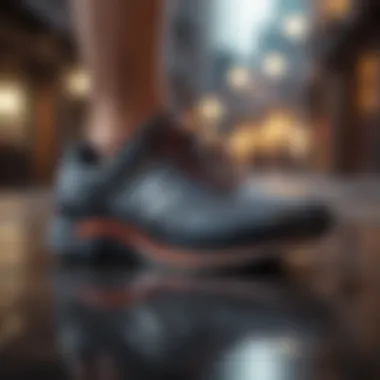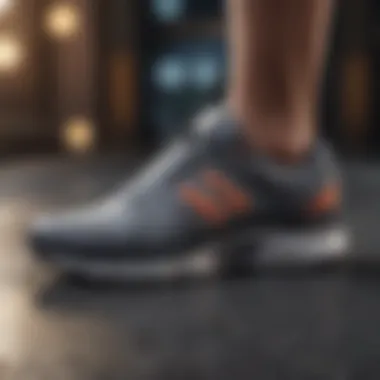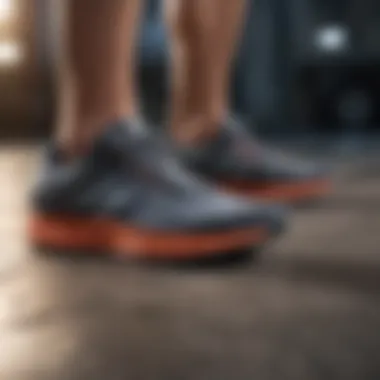Top Running Shoes for Men with Flat Feet


Intro
Selecting the right running shoes can profoundly influence the comfort and performance of individuals with flat feet. Flat feet, also known as pes planus, occur when the arch of the foot is lower than normal or absent. This condition can lead to various complications, such as discomfort, instability, and increased risk of injury during physical activities like running. Therefore, choosing shoes that provide adequate support is crucial.
This article aims to explore the unique requirements of men with flat feet when it comes to running shoes. We will discuss what to look for in terms of support, cushioning, and stability, and highlight specific models that excel in these areas. By the end of this guide, readers should have a clear understanding of how to select the most appropriate running shoes, addressing their needs and enhancing their overall running experience.
Wellness Insights
Benefits of Regular Exercise
Engaging in regular exercise is indispensable for maintaining physical health, particularly for those who may experience pain or discomfort from flat feet. Running can be especially beneficial as it helps to strengthen relevant muscles, improve cardiovascular health, and increase endurance. For men with flat feet, strengthening the muscles around the foot can help mitigate the effects of their condition and improve overall stability.
Some potential benefits of regular exercise include:
- Improved mood and reduced anxiety
- Enhanced physical stamina and strength
- Better weight management
- Higher energy levels throughout the day
It is crucial to acknowledge that men with flat feet may face unique challenges while exercising. Proper footwear is integral to overcoming these challenges effectively.
Understanding Foot Health
Foot health goes beyond comfort; it can significantly impact overall wellness. Poor footwear choices can exacerbate issues like plantar fasciitis, shin splints, and knee pain. Men who engage in running should prioritize finding shoes that provide essential arch support and stability.
"Proper footwear is not just a luxury; it is a necessity for maintaining foot health and optimizing running performance for those with flat feet."
By taking into account the specific needs of flat feet, individuals can significantly improve both their daily comfort and their exercise routine.
Key Features of Running Shoes for Flat Feet
When searching for running shoes, certain features can enhance performance and comfort for men with flat feet. These include:
- Arch support: Shoes should offer substantial support for the arch to prevent overpronation, which is common in flat-footed individuals.
- Cushioning: A well-cushioned shoe absorbs shock effectively, decreasing stress on the feet and joints.
- Stability features: Look for shoes that can help keep the foot stable to prevent excessive movement, which may lead to injury.
- Breathability: Materials that allow airflow can help keep feet dry and comfortable during runs.
By focusing on these key characteristics, men with flat feet can ensure a more satisfying running experience, potentially minimizing the risk of discomfort and injuries.
Understanding Flat Feet
Understanding flat feet is crucial for optimizing running performance and ensuring overall foot health. Flat feet, also known as pes planus, refer to a condition where the arch of the foot collapses, leading to the entire foot making contact with the ground. This condition can affect not only running efficiency but also general mobility. Men with flat feet may experience discomfort when wearing inappropriate footwear, which highlights the need for shoes that provide adequate support and cushioning.
What Are Flat Feet?
Flat feet occur when the arches of the feet fail to develop properly. This results in the foot appearing flat and lacking the standard curvature. While some men are born with flat feet, others may develop the condition over time due to various factors. It is important to recognize that flat feet can vary in severity—from flexible flat feet, where the arch appears when not bearing weight, to rigid flat feet that do not show an arch at any time.
Common Causes of Flat Feet
Several factors may contribute to the development of flat feet. Some common causes include:


- Genetics: A family history of flat feet often increases the likelihood of developing the condition.
- Injury: Trauma to the foot or ankle can disrupt the structure and function, leading to flat feet.
- Age: As individuals age, the ligaments and tendons supporting the arch may weaken.
- Obesity: Excess weight can put additional stress on the feet, exacerbating flat foot conditions.
- Medical Conditions: Certain conditions, such as rheumatoid arthritis or diabetes, can also lead to or worsen flat feet.
Awareness of these causes is vital for effectively addressing and managing flat feet.
Symptoms Associated with Flat Feet
Men with flat feet may experience various symptoms that can affect their daily lives and athletic performance. These symptoms include:
- Pain or Discomfort: Often occurring in the foot, arch, ankle, or lower back, pain may increase during or after physical activity.
- Swelling: Some individuals may notice swelling in the feet or ankles, particularly after standing or walking for extended periods.
- Fatigue: Flat feet can lead to quicker fatigue while walking or running, making exercise more challenging.
- Pronation: This condition often causes overpronation, where the ankles roll inward excessively, impacting running mechanics.
Recognizing these symptoms is the first step towards seeking appropriate footwear and interventions that facilitate a more comfortable running experience.
Importance of Proper Footwear
Proper footwear plays a crucial role for men with flat feet, as it directly impacts their overall comfort and performance during running. The unique structure of flat feet can lead to a variety of issues if not supported properly, making the right choice in running shoes vital. Proper shoes not only alleviate discomfort, but they also enhance running efficiency and can help prevent injuries.
Understanding how flat feet affect movement is essential in recognizing why specialized footwear is necessary. When the arches of the foot collapse, excessive pronation occurs, causing the ankle to roll inward. This misalignment can result in pain and discomfort in various parts of the body. As such, shoes that provide proper alignment and support are fundamental in addressing these issues.
Effects of Flat Feet on Running
Flat feet can have several adverse effects on one's running experience. First, they often create an imbalance that alters the body's biomechanics. This change can lead to substantial strain on the knees, hips, and lower back. Furthermore, runners with flat feet tend to tire more quickly if their footwear does not offer adequate support. The discomfort may manifest as pain in areas such as the arches or heels, making each run a struggle rather than a pleasure.
Here are some common effects associated with flat feet:
- Increased risk of injuries, including plantar fasciitis and shin splints.
- Decreased energy efficiency, requiring more effort when running.
- Potential for developing knee and hip problems due to altered gait.
Selecting running shoes designed for flat feet can significantly diminish these risks and improve overall performance, providing essential support to balance the body and enhance stamina.
Role of Running Shoes in Injury Prevention
Running shoes specifically tailored for flat feet add an essential layer of protection against injuries. Inappropriate or worn-out footwear can exacerbate the discomfort associated with flat feet. Therefore, proper shoes with adequate arch support play a pivotal role in injury prevention. These shoes are designed to accommodate the specific movements of flat-footed runners, ensuring that the foot maintains its necessary position throughout the running stride.
There are several key functions provided by suitable running shoes:
- Arch Support: Proper arch support combats overpronation and encourages a normal running gait.
- Cushioning: Adequate cushioning absorbed impact forces, reducing stress on the muscles and joints.
- Stability and Motion Control: These features provide better control over advanced pronation, minimizing the risk of injuries.
By investing in quality running shoes, men with flat feet can enjoy a more comfortable running experience while significantly reducing their risk of injury. This proactive approach to footwear can lead to a healthier and more enjoyable running journey.
"Choosing the right shoes can transform your running experience, turning potential pain into comfort."
Key Features to Look For
When selecting running shoes for men with flat feet, it is crucial to focus on distinct features that cater to their specific needs. This aims to ensure optimal comfort and support during running. The characteristics discussed in this section play a vital role in enhancing performance and minimizing injury risk. Each feature contributes significantly to addressing the challenges associated with flat feet.
Arch Support Requirements
Arch support is a fundamental requirement for flat feet. The lack of a defined arch can lead to overpronation, where the foot rolls inward excessively. This can increase the risk of injuries over time. Choosing shoes with adequate arch support helps in distributing body weight evenly, stabilizing the foot during movement.


Look for shoes that have built-in arch support or the option to insert orthotics. Brands such as Asics and Brooks often provide models specifically designed for this purpose. Testing arch support involves evaluating how well the shoe cradles the arch and maintains proper alignment.
Cushioning Needs
Cushioning is another significant feature to consider. Flat feet often bring about discomfort during running, and proper cushioning can mitigate this problem. The right amount of cushioning absorbs impact, minimizing stress on joints.
Men with flat feet should look for shoes that provide a balance between cushioning and responsiveness. Too much cushioning can lead to instability, while too little can cause discomfort. Brands like New Balance and Saucony have models known for their effective cushioning systems. It is important to try them on and walk or run a few steps to gauge the comfort level.
Stability vs. Motion Control
Understanding the distinction between stability shoes and motion control shoes is essential. Stability shoes cater to individuals who might slightly overpronate without excessive foot motion. On the other hand, motion control shoes are designed for more severe overpronation. Flat-footed individuals often benefit from motion control shoes, as they offer additional support and help in reducing excess foot movement.
Brands like Nike and Hoka One One offer models that provide excellent stability features, which can support and stabilize the foot for flat-footed runners. Assessing your foot motion during activity can guide you towards the right choice between stability and motion control.
Width Considerations
Lastly, width is a key feature when selecting running shoes. Flat feet can often require a wider shoe to accommodate the foot's shape. A shoe that is too narrow can cause discomfort and lead to blisters or calluses. When trying on shoes, it is important to ensure that there is enough room in the toe box and that the width fits comfortably without pinching.
Many brands produce shoes in various widths, but it is crucial to pay attention to sizing charts and try them on while wearing the type of socks you would use for running. Proper fit in terms of width can make a significant difference in overall comfort and performance.
"A well-fitted shoe can be the difference between a good run and one that leads to injury."
Top Running Shoe Models for Flat Feet
Selecting suitable running shoes is pivotal for men with flat feet. When feet lack the needed arch, they can lead to imbalances during running. This imbalance increases the risk of injuries and discomfort. Proper footwear can provide crucial support. Therefore, finding the ideal shoe models is essential.
Brand A: Features and Benefits
The Asics Gel-Kayano is known for its exceptional stability and support. It provides a well-cushioned experience. The medial support helps reduce overpronation. This is particularly beneficial for individuals with flat feet. The gel cushioning system absorbs shock, making it ideal for long distances. Users appreciate its comfortable fit and durability. It is also worth noting that this model works well for those who prefer a snug fit.
Brand B: Features and Benefits
Brooks Adrenaline GTS has become popular among runners with flat feet. This shoe offers a balance of cushioning and support. It features a guide rail system that aligns the body's natural motion. The cushioning is responsive and soft, which enhances comfort during runs. Additionally, the shoe comes in different widths, ensuring a proper fit for all foot shapes. This is valuable for individuals needing a roomier toe box or a tighter heel fit.
Brand C: Features and Benefits
New Balance 860 comes with a flexible yet sturdy design. This running shoe emphasizes stability without sacrificing comfort. The Fresh Foam midsole provides a soft landing. It helps to reduce fatigue over long distances. The shoe's construction allows for an effective lockdown around the midfoot. This feature is essential for maintaining proper foot alignment, particularly for men with flat feet. It also showcases excellent breathability, making it suitable for diverse weather conditions.
A well-chosen running shoe can significantly improve the overall running experience for individuals with flat feet.
Assessment of Fit and Comfort
Proper fit and comfort in running shoes is essential, especially for men with flat feet. When your feet do not have the proper arch support, the shoes must compensate to minimize discomfort and injury risk. A well-fitted shoe enhances running efficiency, reduces fatigue, and allows the runner to focus on performance rather than pain. The implications of not achieving a suitable fit can be wide-ranging, from minor discomfort to significant injuries that could deter one from running entirely.
How to Evaluate Shoe Fit
Evaluating the fit of running shoes is a process that involves several critical elements. The following points can help in assessing if a shoe is the right fit:


- Heel Fit: The shoe should fit snugly around the heel without excess movement. A proper heel fit reduces the risk of blisters and irritation.
- Toe Room: There must be adequate space in the toe box to allow for foot expansion while running. A general guideline is to ensure there is about half an inch of space between the longest toe and the front of the shoe.
- Midfoot Security: The midfoot should feel secure in the shoe without being overly tight. A good fit here helps with stability and control during runs.
- Flexibility: The shoe should flex naturally with your foot. Look for shoes that bend around the ball of the foot rather than in the middle.
Ultimately, trying on shoes at the end of the day when your feet are slightly swollen can lead to a more accurate fit evaluation.
Testing for Comfort During a Run
Comfort during an actual run is critical not just for enjoyment but also for performance improvement. The following methods can be used to test for comfort:
- Initial Test Run: After selecting potential shoes, running for a short distance is advisable. Assess how they feel after a warm-up. Pay attention to any pinching or pressure points.
- Surface Variety: Run on different surfaces to see how the shoes handle various terrains. This will simulate real running conditions.
- Duration: Time the run to see if comfort decreases over longer distances. What feels suitable for a short run might not hold up during longer runs.
Foot Care and Health Considerations
Understanding foot care is crucial for individuals with flat feet. The unique structure of flat feet requires specific attention to maintain overall foot health and prevent common problems associated with this condition. Poor foot care can lead to discomfort and injuries, particularly during high-impact activities like running. Therefore, prioritizing foot health is not only about comfort; it can significantly enhance performance and longevity in running.
Importance of Orthotic Inserts
Orthotic inserts are an essential element for many runners with flat feet. These inserts provide additional arch support that standard insoles may lack. They help distribute weight evenly across the foot, reducing excessive pressure on specific areas. As a result, they can minimize pain in the feet, shins, knees, and even the lower back.
The benefits of orthotic inserts include:
- Customizability: They can be tailored to individual foot shapes, improving fit.
- Injury Prevention: By offering extra support, they help prevent common running injuries such as plantar fasciitis and shin splints.
- Comfort during Runs: Enhanced cushioning can lead to more enjoyable runs due to reduced fatigue.
Consider consulting a podiatrist to assess the need for orthotic inserts. They can provide recommendations based on your specific needs and running style.
Routine Foot Care Practices
Engaging in routine foot care practices is vital for individuals with flat feet. Regular attention can greatly enhance comfort and performance while helping to stave off foot-related issues. Some key practices include:
- Regular Inspections: Look for any abnormalities such as swelling or discoloration, which may indicate issues.
- Proper Hygiene: Keeping feet clean and dry can prevent fungal infections and other skin problems.
- Moisturizing: Apply moisturizer to prevent dry skin, but avoid the areas between the toes to reduce the risk of fungal infections.
- Strengthening Exercises: Strengthening the muscles and tendons in the feet can improve stability. Simple exercises, like toe curls and balancing on one foot, can be very effective.
- Appropriate Footwear: Always wear shoes that fit well and provide the necessary support.
Regular foot care is key to maintaining a healthy running routine for men with flat feet.
In summary, foot care and health considerations play a pivotal role in enhancing running performance for those with flat feet. Incorporating orthotic inserts and following regular foot care practices can lead to a more enjoyable and injury-free running experience.
Finale
The conclusion of this article emphasizes the critical nature of selecting the right running shoes for men with flat feet. Individuals with flat feet face unique challenges that can impact their running experience and overall foot health. Understanding the distinct requirments of flat-footed runners helps to recognize the importance of proper footwear.
Summary of Key Points
In summary, our discussion highlighted crucial elements regarding running shoes tailored for flat feet.
- Understanding Flat Feet: Flat feet can lead to various biomechanical issues affecting how a person walks or runs.
- Importance of Proper Footwear: Proper shoes can significantly influence running performance and reduce injury risk.
- Key Features: Factors like arch support, cushioning, and stability should be prioritized when selecting shoes.
- Top Models: Specific brands and models were identified that cater specifically to the needs of flat-footed runners.
- Foot Care Considerations: Regular foot care and the use of orthotic inserts were discussed as essential elements for maintaining foot health.
These points collectively present a framework to navigate the often-overwhelming market of running shoes. Awareness of individual foot mechanics is essential for achieving optimum performance.
Final Thoughts on Choosing Running Shoes
Ultimately, choosing the right running shoes is more than just a practical decision; it's a step towards ensuring comfort, performance, and injury prevention. Many options exist, yet only a few truly cater to the needs of those with flat feet. When shopping for running shoes, consider the following:
- Try Shoes On: Always test shoes in-store, taking care to walk and jog in them for comfort.
- Consult Professionals: Engaging health professionals or specialized running coaches can provide customized insights.
- Consider Custom Insoles: If standard shoes do not offer the needed support, consider investing in custom orthotic insoles.
Ultimately, the right footwear can lead to a more enjoyable and injury-free running journey.



